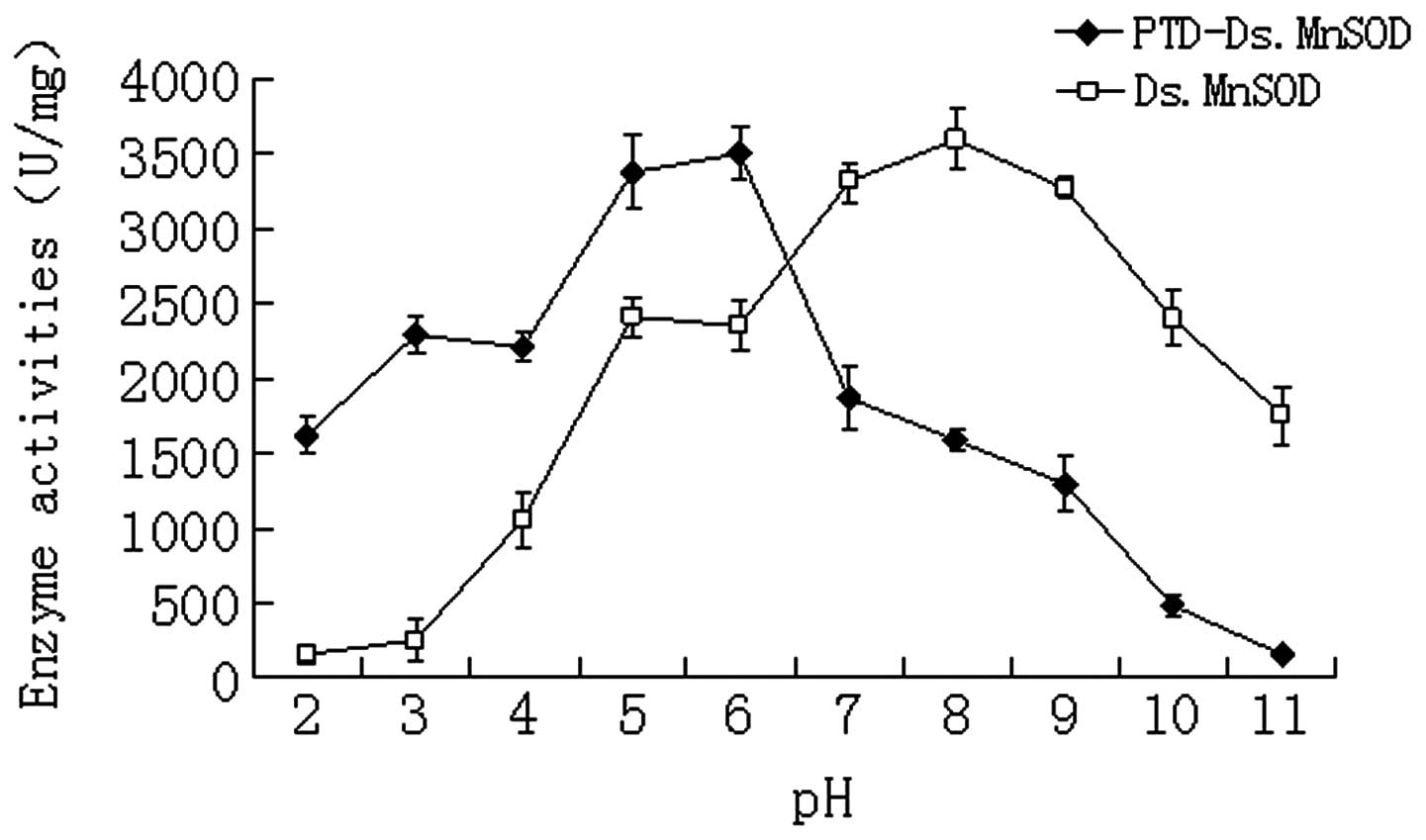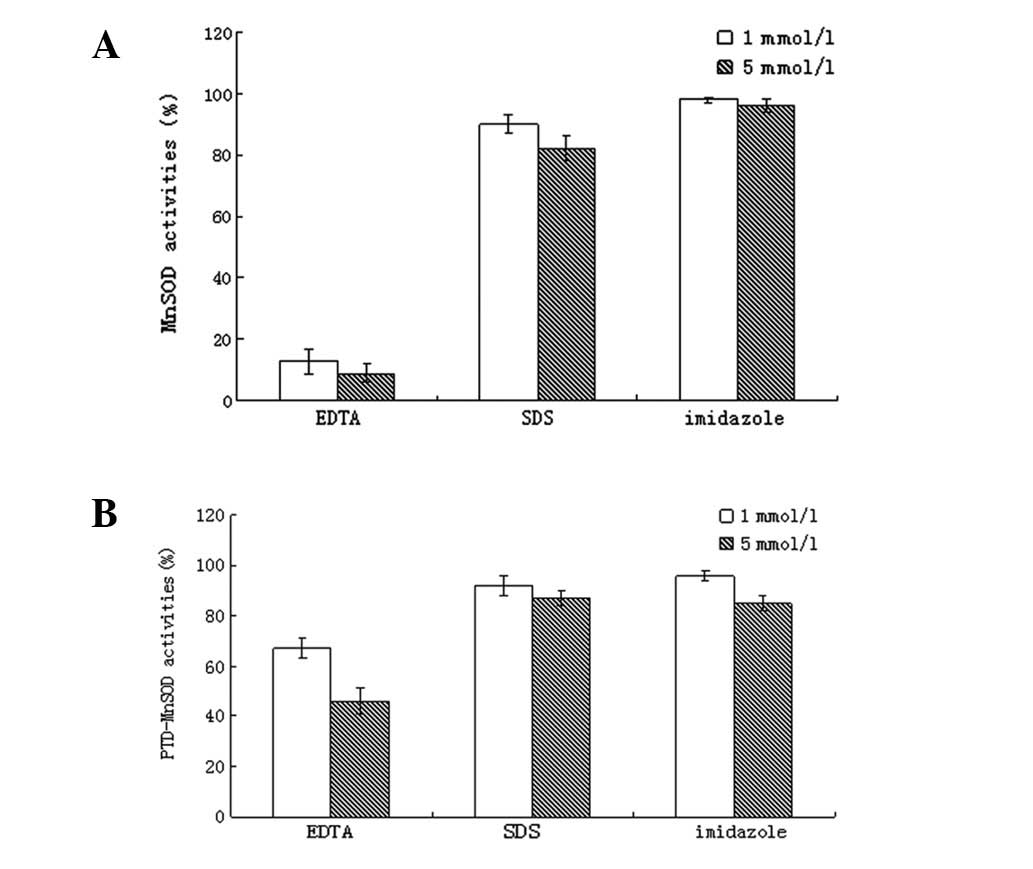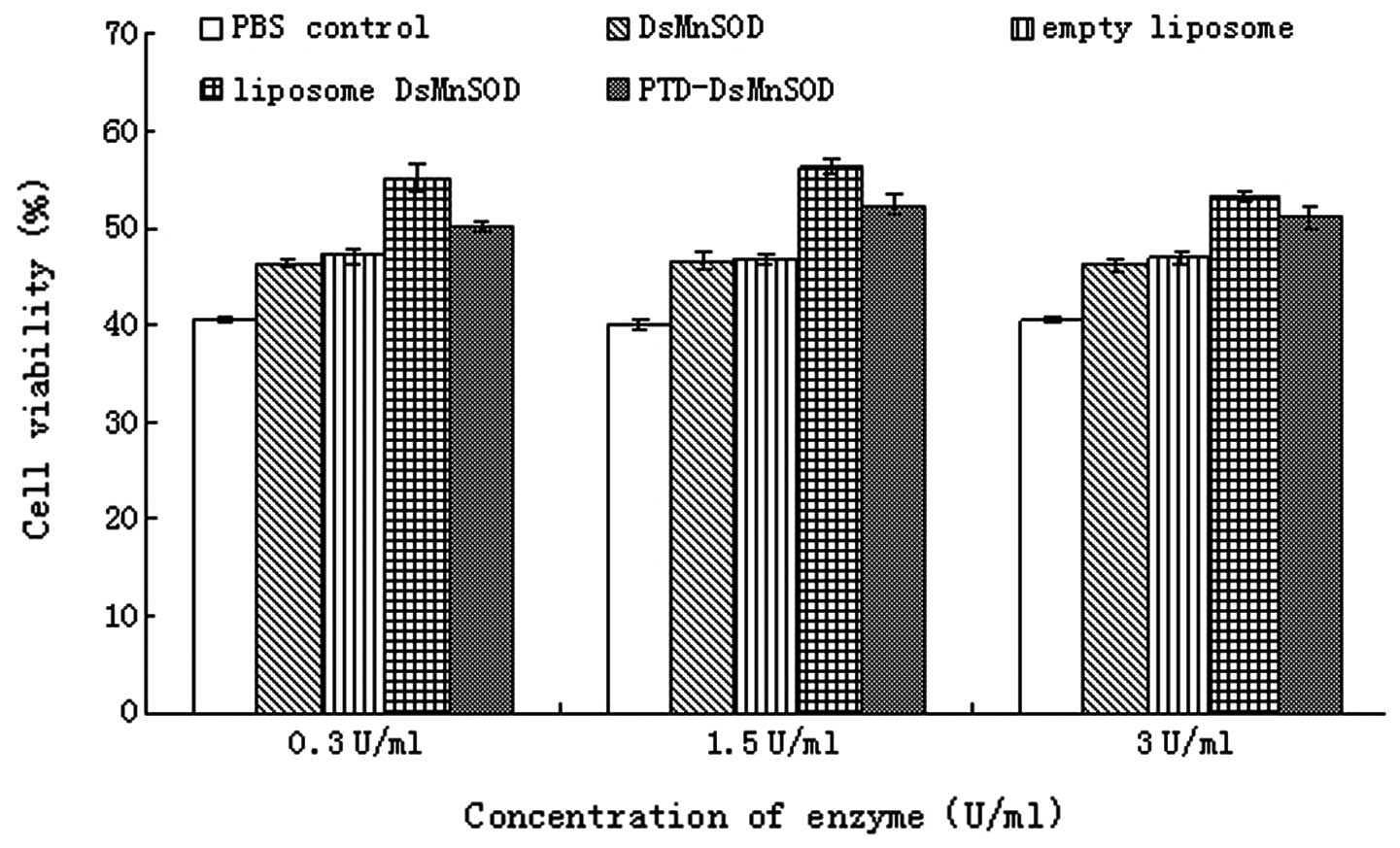|
1
|
Haghjou MM, Shariati M and Smirnoff N: The
effect of acute high light and low temperature stresses on the
ascorbate-glutathione cycle and superoxide dismutase activity in
two Dunaliella salina strains. Physiol Plantarum.
135:272–280. 2009. View Article : Google Scholar : PubMed/NCBI
|
|
2
|
Tian J and Yu J: Changes in ultrastructure
and responses of antioxidant systems of algae (Dunaliella
salina) during acclimation to enhanced ultraviolet-B radiation.
J Photochem Photobiol B. 97:152–160. 2009. View Article : Google Scholar : PubMed/NCBI
|
|
3
|
Zhang S, Li XR, Xu H, Cao Y, Ma SH, Cao Y
and Qiao D: Molecular cloning and functional characterization of
MnSOD from Dunaliella salina. J Basic Microbiol. May
26–2013.(Epub ahead of print).
|
|
4
|
Green M, Ishino M and Loewenstein PM:
Mutational analysis of HIV-1 Tat minimal domain peptides:
identification of trans-dominant mutants that suppress
HIV-LTR-driven gene expression. Cell. 58:215–223. 1989. View Article : Google Scholar : PubMed/NCBI
|
|
5
|
Green M and Loewenstein PM: Autonomous
functional domains of chemically synthesized human immunodeficiency
virus tat trans-activator protein. Cell. 55:1179–1188. 1988.
View Article : Google Scholar : PubMed/NCBI
|
|
6
|
Vivès E, Granier C, Prevot P and Lebleu B:
Structure activity relationship study of the plasma membrane
translocating potential of a short peptide from HIV-1 Tat protein.
Lett Pept Sci. 4:429–436. 1997.
|
|
7
|
Beerens AM, Al Hadithy AF, Rots MG and
Haisma HJ: Protein transduction domains and their utility in gene
therapy. Curr Gene Ther. 3:486–494. 2003. View Article : Google Scholar : PubMed/NCBI
|
|
8
|
Haenssle HA, Riedl P, Buhl T, Schardt A,
Rosenberger A, Schön MP and Schirmbeck R: Intracellular delivery of
major histocompatibility complex class I-binding epitopes:
dendritic cells loaded and matured with cationic peptide/poly(I:C)
complexes efficiently activate T cells. Exp Dermatol. 19:19–28.
2010. View Article : Google Scholar
|
|
9
|
Chugh A, Amundsen E and Eudes F:
Translocation of cell-penetrating peptides and delivery of their
cargoes in triticale microspores. Plant Cell Rep. 28:801–810. 2009.
View Article : Google Scholar : PubMed/NCBI
|
|
10
|
Ding W, Liu S and Rao P: Use of protein
transduction domain-superoxide dismutase fusion protein for
preparing anti-drunk and anti-alcohol product China Patent no.
C2010H43227. Filed Dec 14, 2009; issued Sep 6, 2010.
|
|
11
|
Liu S and Rao P: Use of fusion protein
glutathione-S-transferase-pentanedial-superoxide-dismutase for
radio-resistance, comprises 2,4,6-triaziridin-1-yl-1,3,5-triazine
protein transduction domain which are connected with super-oxide
dismutase China Patent no. C2008-256140. Filed August 30, 2007;
issued March 19, 2008.
|
|
12
|
Liu S, Rao P and Yang Y: Use of protein
transduction domain-superoxide dismutase fusion protein in
antifatigue product or medicine for protecting or repairing cells
with damaged free radical, or improving antifatigue ability of
organism China Patent no. C2009Q75989. Filed November 5, 2008;
issued October 14, 2009.
|
|
13
|
Eum WS, Jang SH, Kim DW, Choi HS, Choi SH,
Kim SY, An JJ, Lee SH, Han K, Kang JH, Kang TC, Won MH, Cho YJ,
Choi JH, Kim TY, Park J and Choi SY: Enhanced transduction of
Cu,Zn-superoxide dismutase with HIV-1 Tat protein transduction
domains at both termini. Mol Cells. 19:191–197. 2005.PubMed/NCBI
|
|
14
|
Kim DW, Eum WS, Jang SH, Kim SY, Choi HS,
Choi SH, An JJ, Lee SH, Lee KS, Han K, Kang TC, Won MH, Kang JH,
Kwon OS, Cho SW, Kim TY, Park J and Choi SY: Transduced Tat-SOD
fusion protein protects against ischemic brain injury. Mol Cells.
19:88–96. 2005.PubMed/NCBI
|
|
15
|
Kigasawa K, Miyashita M, Kajimoto K,
Kanamura K, Harashima H and Kogure K: Efficient intradermal
delivery of superoxide dismutase using a combination of liposomes
and iontophoresis for protection against UV-induced skin damage.
Biol Pharm Bull. 35:781–785. 2012. View Article : Google Scholar : PubMed/NCBI
|
|
16
|
Umakoshi H, Morimoto K, Yasuda N,
Shimanouchi T and Kuboi R: Development of liposome-based mimics of
superoxide dismutase and peroxidase based on the “LIPOzyme”
concept. J Biotechnol. 147:59–63. 2010.PubMed/NCBI
|
|
17
|
Kanehisa M, Asayama S and Kawakami H:
Design of lipoprotein-adsorbed liposomes retaining Mn-porphyrins
for SOD mimic delivery to brains. Desalin Water Treat. 17:31–36.
2010. View Article : Google Scholar
|
|
18
|
Umakoshi H, Tuan LQ, Shimanocuhi T and
Kuboi R: Role of liposome on recognition and folding of oxidized
and fragmented superoxide dismutase for its re-activation. Biochem
Eng J. 46:313–319. 2009. View Article : Google Scholar
|
|
19
|
Szoka F, Olson F, Heath T, Vail W, Mayhew
E and Papahadjopoulos D: Preparation of unilamellar liposomes of
intermediate size (0.1–0.2 mumol) by a combination of reverse phase
evaporation and extrusion through polycarbonate membranes. Biochim
Biophys Acta. 601:559–571. 1980.PubMed/NCBI
|
|
20
|
Youan BB: Microencapsulation of superoxide
dismutase into poly(epsilon-caprolactone) microparticles by reverse
micelle solvent evaporation. Drug Deliv. 10:283–288. 2003.
View Article : Google Scholar : PubMed/NCBI
|
|
21
|
Aoki H, Fujita M, Sun CQ, Fuji K and
Miyajima K: High-efficiency entrapment of superoxide dismutase into
cationic liposomes containing synthetic aminoglycolipid. Chem Pharm
Bull (Tokyo). 45:1327–1331. 1997. View Article : Google Scholar : PubMed/NCBI
|
|
22
|
Rengel RG, Filipović-Grcić J, Cepelak I,
Zanić-Grubisić T and Barisić K: The effect of liposomes with
superoxide dismutase on A2182 cells. Eur J Pharm Biopharm.
60:47–51. 2005. View Article : Google Scholar : PubMed/NCBI
|
|
23
|
Kim HA, Kim DW, Park J and Choi SY:
Transduction of Cu, Zn-superoxide dismutase mediated by an HIV-1
Tat protein basic domain into human chondrocytes. Arthritis Res
Ther. 8:R962006. View
Article : Google Scholar : PubMed/NCBI
|
|
24
|
Kwon HY, Eum WS, Jang HW, Kang JH, Ryu J,
Ryong Lee B, Jin LH, Park J and Choi SY: Transduction of
Cu,Zn-superoxide dismutase mediated by an HIV-1 Tat protein basic
domain into mammalian cells. FEBS Lett. 485:163–167. 2000.
View Article : Google Scholar : PubMed/NCBI
|
|
25
|
Tsai CF, Lu FJ and Hsu YW: Protective
effects of Dunaliella salina - a carotenoids-rich alga -
against ultraviolet B-induced corneal oxidative damage in mice. Mol
Vis. 18:1540–1547. 2012.
|
|
26
|
Pan J, Su Y, Hou X, He H, Liu S, Wu J and
Rao P: Protective effect of recombinant protein SOD-TAT on
radiation-induced lung injury in mice. Life Sci. 91:89–93. 2012.
View Article : Google Scholar : PubMed/NCBI
|
|
27
|
Beauchamp C and Fridovich I: Superoxide
dismutase: improved assays and an assay applicable to acrylamide
gels. Anal Biochem. 44:276–287. 1971. View Article : Google Scholar : PubMed/NCBI
|
|
28
|
Fung H and Demple B: A vital role for
Ape1/Ref1 protein in repairing spontaneous DNA damage in human
cells. Mol Cell. 17:463–470. 2005. View Article : Google Scholar : PubMed/NCBI
|
|
29
|
Hashimoto D, Ohmuraya M, Hirota M,
Yamamoto A, Suyama K, Ida S, Okumura Y, Takahashi E, Kido H, Araki
K, Baba H, Mizushima N and Yamamura K: Involvement of autophagy in
trypsinogen activation within the pancreatic acinar cells. J Cell
Biol. 181:1065–1072. 2008. View Article : Google Scholar : PubMed/NCBI
|
|
30
|
Chwa M, Atilano SR, Reddy V, Jordan N, Kim
DW and Kenney MC: Increased stress-induced generation of reactive
oxygen species and apoptosis in human keratoconus fibroblasts.
Invest Ophthalmol Vis Sci. 47:1902–1910. 2006. View Article : Google Scholar : PubMed/NCBI
|
|
31
|
Fabani MM, Gargini R, Taira MC, Iacono R
and Alonso-Romanowski S: Study of in vitro stability of liposomes
and in vivo antibody response to antigen associated with liposomes
containing GM1 after oral and subcutaneous immunization. J Liposome
Res. 12:13–27. 2002. View Article : Google Scholar : PubMed/NCBI
|
|
32
|
Li H, Shu T, Kuma H, Ueda Y, et al:
Ribonucleoprotein complex originating in Paramyxovirus incapable of
expressing some envelope proteins, for insertion into target cell
with avoidance of problems with antigenicity and cytotoxicity, for
use e.g. in gene therapy Japan Patent no. C2001-001931. Filed May
18, 1999; issued November 23, 2000.
|
|
33
|
Natsume A, Mizuno M, Ryuke Y and Yoshida
J: Cationic liposome conjugation to recombinant adenoviral vector
reduces viral antigenicity. Jpn J Cancer Res. 91:363–367. 2000.
View Article : Google Scholar : PubMed/NCBI
|
|
34
|
Steel JC, Cavanagh HM, Burton MA and Kalle
WH: Microsphere-liposome complexes protect adenoviral vectors from
neutralising antibody without losses in transfection efficiency,
in-vitro. J Pharm Pharmacol. 56:1371–1378. 2004. View Article : Google Scholar
|
|
35
|
Arora N and Gangal SV: Efficacy of
liposome entrapped allergen in down regulation of IgE response in
mice. Clin Exp Allergy. 22:35–42. 1992. View Article : Google Scholar : PubMed/NCBI
|
|
36
|
Costanzo LL, De Guidi G, Giuffrida S,
Sortino S and Condorelli G: Antioxidant effect of inorganic ions on
UVC and UVB induced lipid peroxidation. J Inorg Biochem. 59:1–13.
1995. View Article : Google Scholar : PubMed/NCBI
|
|
37
|
Dave N and Liu J: Protection and promotion
of UV radiation-induced liposome leakage via DNA-directed assembly
with gold nanoparticles. Adv Mater. 23:3182–3186. 2011. View Article : Google Scholar : PubMed/NCBI
|
|
38
|
Fan R, Gan L, Liu M, Zhu D and Chen L, Xu
Z, Hao Z and Chen L: An interaction of helicid with liposome
biomembrane. Appl Surf Sci. 257:2102–2106. 2011. View Article : Google Scholar
|
|
39
|
Kato S, Kikuchi R, Aoshima H, Saitoh Y and
Miwa N: Defensive effects of fullerene-C60/liposome complex against
UVA-induced intracellular reactive oxygen species generation and
cell death in human skin keratinocytes HaCaT, associated with
intracellular uptake and extracellular excretion of fullerene-C60.
J Photochem Photobiol B. 98:144–151. 2010. View Article : Google Scholar
|














